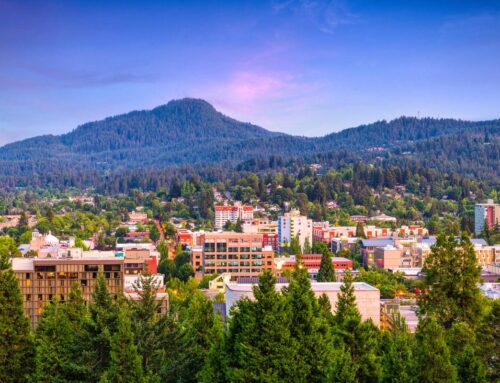One of the most fascinating places in the whole world is right here in Oregon, and it’s known as Crater Lake National Park. Crater Lake is known as one of the seven wonders of Oregon. Probably the most talked about tourist attraction in Oregon, 500,000 people come yearly to see this magnificent body of water which stretches 183,224 acres in southern Oregon. The origins of Crater Lake date back millions of years.
1. A man in Kansas led to Crater Lake being designated as a national park.
William Gladstone Steel is considered to be the “Father of Crater Lake” and first read about Crater Lake in a newspaper as a child, back in 1870 while living in Kansas. He dreamed to visit the lake one day, and got his chance in 1885. Steel vowed to have Crater Lake named as a national park, which eventually happened on May 22, 1902.

2. Crater Lake weather is known to be somewhat extreme.
From October through June, the park is covered in snow, and is known to stick until around July. Crater Lake averages about 66 inches and the amount of snow is just as impressive. Crater Lake has an average annual snowfall of 44 feet, and during the winter can reach about 18 degrees Fahrenheit, with summer temperatures soaring to 90 degrees Fahrenheit.
While it came close to a total freeze in 1985, the last time Crater Lake National Park was completely frozen was in 1949.

3. Crater Lake was formed by a volcano.
The history of how this park began is absolutely incredible. Crater Lake sits in the caldera of the collapsed volcano Mount Mazama and is surrounded by incredible old-growth forests, evergreens, and of course volcano remnants. Mount Mazama formed half a million years ago and erupted around 7,700 years ago.
4.The mysterious The Old Man Of The Lake.
For reasons unknown, this full-sized tree trump floating vertically in Crater Lake has been here for 120 years. It’s known as The Old Man Of The Lake, an ancient hemlock tree which first appeared in 1902. This was the same year Crater Lake was named a national park. This story is probably the park’s most famous phenomenon.
A geologist by the name of Joseph S. Diller first mentioned seeing the amazing stump six years earlier new Wizard Island at Crater Lake’s west end, when reporting on the cataclysmic events which shaped the area. In 1929, William Gladstone Steel mentioned seeing “the great tree, broken squarely off and floating upright.”
5. Crater Lake is surprisingly a dangerous place.
The only national park in Oregon is home to a number of mysterious deaths, with only bones left behind to help us understand what caused their death. One mysterious death goes all the way back to the summer of 1974, 19-year-old Charles McCullar photographer left his home state of Virginia and set out to visit Crater Lake National Park. He left Eugene, Oregon, where he was staying for a few weeks and left on a short excursion, hitchhiking to Crater Lake for some winter photos.
He had planned to return home to his friend’s house two days later and never returned. You can read more about the mysterious deaths at Crater Lake here.
6. Crater Lake is the deepest lake in the United States.
Not only is Crater Lake the deepest lake in the United States, it also ranks as the ninth deepest lake in the world. The actual depth of Crater Lake bottoms out at an astounding 1,943 feet.
7. Crater Lake is incredibly clear.

The lake is so clear in fact, you can see over 100 feet down. The awesome pristine blue and clear water makes this place popular for boat tours and is an incredible sight when visiting.
8. In the middle of Crater Lake is a beautiful ship-shaped island.
The island is an ancient rock formation appearing to resemble a large, abandoned sea vessel which towers around 170 feet above the water. This phenomenal island is known as the Phantom Ship and is a remaining section of the filled conduit of a fissure from which probably poured many of the lower layers of lava constituting Dutton Cliff.
9. Crater Lake National Park offers camping and hiking nearby.
Not only can you camp at Crater Lake, as this state park offers over 200 sites at Mazama Village, you can also hike here. Unlike other national parks, Crater Lake has a few hiking trails, around 5 ranging in distance from half a mile to 5 miles.
10. Swimming is permitted at Crater Lake national park.
While you can swim in the magnificent lake, there’s only one spot where it’s considered safe(and legal) to get down to the lake shore. It’s the Cheetwood Cove Trail and usually opens mid to late June. The trail is a little over a mile long and drops nearly 700 feet down to the lake shore. Visitors are welcome to swim in the lake from the shoreline at the end of this trail.
11. Bald eagles can be seen at Crater Lake National Park often.
You can see Bald Eagles at Crater Lake fairly often in the summer, especially from boats. While Golden Eagles area rare sight, they usually make an appearance a couple times a year. The most common birds seen in the park are: Raven, Clark’s Nutcracker, Gray Jay, Steller’s Jay, Dark-Eyed Junco, and Mountain Chickadee.
12. You can see a pumice castle at Crater Lake.

The park even has a bright, rust-colored Pumice Castle outcropping on the eastern wall of the caldera.
13. There are no streams flowing in or out of Crater Lake.
All of the water in the lake comes from rain and snowmelt, which explains why the water’s clarity and why it so incredibly blue.
14. Needle-like Rock formations were revealed after years of erosion.
Rising above the Sand Creek Canyon you’ll find tall skinny rocks which once acted as vents for steam and gas, which swirled below the canyon’s surface. The rising heat solidified the ash into the towering pumice rocks that stand at over 50 feet.
15. Wizard Island was named for it’s resemblance to a sorcerer’s hat.

16. Crater Lake has an awesome historic lodge.

The Crater Lake Lodge originally opened in 1915, and had extensive renovations done in 1995. The lodge is reminiscent of the 1920s and immerses visitors in its rustic charm. Each room provides the ideal hotel standards of comfort and privacy in the heart of Crater Lake National Park. The lodge is open seasonally from late-May to mid-October.
Source- https://thatoregonlife.com






